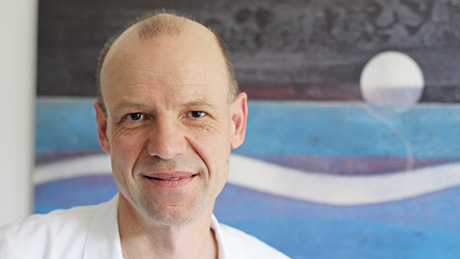Navigation auf uzh.ch
Navigation auf uzh.ch

While HIV-positive people can lead a more or less normal life these days thanks to antiretroviral drugs, so far there’s no actual cure for HIV infection. This is because some of the human immunodeficiency viruses lie hidden and dormant in the patient’s immune cells, in the so-called latent reservoir. While viruses in this hibernation mode don’t multiply and can’t be passed on to other people, once drug therapy stops they switch back to active mode.
The aims of the UZH Viral Infectious Diseases Clinical Research Priority Program (CRPP) include gaining a greater understanding of this latent reservoir. One of its teams is looking into HIV infection, while the other is attempting to track down hitherto unidentified pathogens.
The CRPP is directed by Professor Huldrych Günthard, Deputy Chief of Service at the Division of Infectious Diseases and Hospital Epidemiology at University Hospital Zurich; Professor Alexandra Trkola, head of the Institute of Medical Virology at UZH; and Professor Nicolas Müller, head of the Transplant Center at University Hospital Zurich.
Huldrych Günthard heads the team looking into HIV. The CRPP is an opportunity for him to extend the Zurich Primary HIV Infection Study (ZPHI), initiated in 2002, and to investigate additional research-related questions. Among other things his team is seeking ways of destroying the viruses that slumber in the latent reservoir. “The idea is to activate the dormant viruses to make them vulnerable to attack by antiretroviral drugs and the patient’s immune system.”
Most of the latent reservoir is formed shortly after HIV infection. In earlier work the researchers around Günthard were able to show that the number of viruses in the latent reservoir was about 90 percent lower in patients who received antiretroviral therapy early on.
Now the infectious disease specialists want to find out whether patients with a smaller reservoir can get by with fewer drugs – which would reduce the side-effects and the costs of treatment. Within the framework of another CRPP sub-project, Günthard wants to look into whether interferon treatment at an early stage of HIV infection can help inhibit the growth of the latent reservoir.
The second area covered by the CRPP arose out of clinical practice and therapies for patients with immune deficiencies. The Viral Metagenome Project aims to create a basis for optimizing the treatment of patients with immune deficiencies (people infected with HIV and children with a congenital immune deficiency), and patients with suppressed immune systems (following an organ transplant or chemotherapy).
As a result of their immune deficiency, these people are regularly prone to conditions such as diarrhea, inflammation of the brain, and lung infections. Standard diagnostic methods are unsatisfactory when it comes to identifying the pathogens involved. “So far we’ve only been able to look for pathogens that are already known. But now we have new diagnostic methods that allow us to search for as-yet unidentified viruses,” explains CRPP co-director Alexandra Trkola.
Under the leadership of Trkola and her fellow co-director Nicolas Müller, scientists at the Institute of Medical Virology are using techniques such as next generation sequencing (NGS) to fish for unidentified pathogens in blood, stool and lung mucus samples.
They’ve already notched up their first success by identifying a specific virus as the trigger of lung infection following heart transplant surgery – one that routine diagnostic methods had failed to detect.